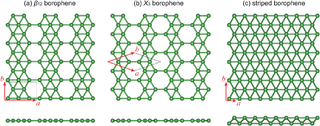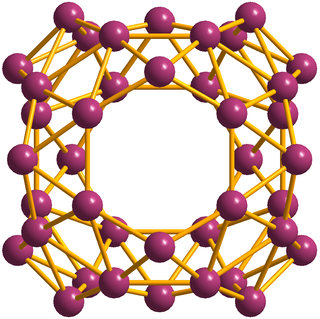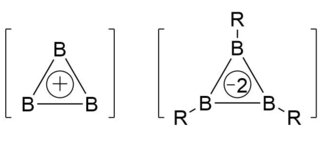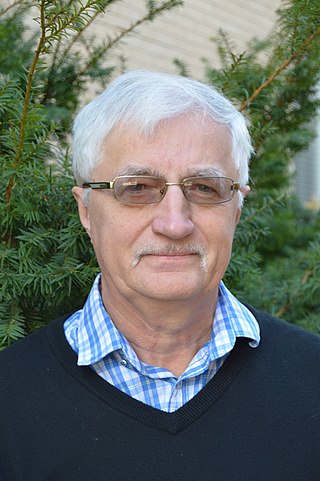In chemistry, the oxidation state, or oxidation number, is the hypothetical charge of an atom if all of its bonds to other atoms were fully ionic. It describes the degree of oxidation of an atom in a chemical compound. Conceptually, the oxidation state may be positive, negative or zero. While fully ionic bonds are not found in nature, many bonds exhibit strong ionicity, making oxidation state a useful predictor of charge.
Gold clusters in cluster chemistry can be either discrete molecules or larger colloidal particles. Both types are described as nanoparticles, with diameters of less than one micrometer. A nanocluster is a collective group made up of a specific number of atoms or molecules held together by some interaction mechanism. Gold nanoclusters have potential applications in optoelectronics and catalysis.
Metal aromaticity or metalloaromaticity is the concept of aromaticity, found in many organic compounds, extended to metals and metal-containing compounds. The first experimental evidence for the existence of aromaticity in metals was found in aluminium cluster compounds of the type MAl−
4 where M stands for lithium, sodium or copper. These anions can be generated in a helium gas by laser vaporization of an aluminium / lithium carbonate composite or a copper or sodium / aluminium alloy, separated and selected by mass spectrometry and analyzed by photoelectron spectroscopy. The evidence for aromaticity in these compounds is based on several considerations. Computational chemistry shows that these aluminium clusters consist of a tetranuclear Al2−
4 plane and a counterion at the apex of a square pyramid. The Al2−
4 unit is perfectly planar and is not perturbed the presence of the counterion or even the presence of two counterions in the neutral compound M
2Al
4. In addition its HOMO is calculated to be a doubly occupied delocalized pi system making it obey Hückel's rule. Finally a match exists between the calculated values and the experimental photoelectron values for the energy required to remove the first 4 valence electrons. The first fully metal aromatic compound was a cyclogallane with a Ga32- core discovered by Gregory Robinson in 1995.

Fullerene chemistry is a field of organic chemistry devoted to the chemical properties of fullerenes. Research in this field is driven by the need to functionalize fullerenes and tune their properties. For example, fullerene is notoriously insoluble and adding a suitable group can enhance solubility. By adding a polymerizable group, a fullerene polymer can be obtained. Functionalized fullerenes are divided into two classes: exohedral fullerenes with substituents outside the cage and endohedral fullerenes with trapped molecules inside the cage.

An artificial enzyme is a synthetic organic molecule or ion that recreates one or more functions of an enzyme. It seeks to deliver catalysis at rates and selectivity observed in naturally occurring enzymes.
Organogold chemistry is the study of compounds containing gold–carbon bonds. They are studied in academic research, but have not received widespread use otherwise. The dominant oxidation states for organogold compounds are I with coordination number 2 and a linear molecular geometry and III with CN = 4 and a square planar molecular geometry.

Borophene is a crystalline atomic monolayer of boron, i.e., it is a two-dimensional allotrope of boron and also known as boron sheet. First predicted by theory in the mid-1990s, different borophene structures were experimentally confirmed in 2015.

Borospherene (B40) is an electron-deficient cluster molecule containing 40 boron atoms. It bears similarities to other homoatomic cluster strucrures such as buckminsterfullerene (C60), stannaspherene, and plumbaspherene, but with a different symmetry. The first experimental evidence for borospherene was reported in July 2014, and is described in the journal Nature Chemistry. The molecule includes unusual hexagonal and heptagonal faces. Despite many calculation-based investigations into its structure and properties, a viable route for the synthesis and isolation of borospherene has yet to be established, and as a consequence it is still relatively poorly understood.
The phosphidosilicates or phosphosilicides are inorganic compounds containing silicon bonded to phosphorus and one or more other kinds of elements. In the phosphosilicates each silicon atom is surrounded by four phosphorus atoms in a tetrahedron. The triphosphosilicates have a SiP3 unit, that can be a planar triangle like carbonate CO3. The phosphorus atoms can be shared to form different patterns e.g. [Si2P6]10− which forms pairs, and [Si3P7]3− which contains two-dimensional double layer sheets. [SiP4]8− with isolated tetrahedra, and [SiP2]2− with a three dimensional network with shared tetrahedron corners. SiP clusters can be joined, not only by sharing a P atom, but also by way of a P-P bond. This does not happen with nitridosilicates or plain silicates.

The triboracyclopropenyl fragment is a cyclic structural motif in boron chemistry, named for its geometric similarity to cyclopropene. In contrast to nonplanar borane clusters that exhibit higher coordination numbers at boron (e.g., through 3-center 2-electron bonds to bridging hydrides or cations), triboracyclopropenyl-type structures are rings of three boron atoms where substituents at each boron are also coplanar to the ring. Triboracyclopropenyl-containing compounds are extreme cases of inorganic aromaticity. They are the lightest and smallest cyclic structures known to display the bonding and magnetic properties that originate from fully delocalized electrons in orbitals of σ and π symmetry. Although three-membered rings of boron are frequently so highly strained as to be experimentally inaccessible, academic interest in their distinctive aromaticity and possible role as intermediates of borane pyrolysis motivated extensive computational studies by theoretical chemists. Beginning in the late 1980s with mass spectrometry work by Anderson et al. on all-boron clusters, experimental studies of triboracyclopropenyls were for decades exclusively limited to gas-phase investigations of the simplest rings (ions of B3). However, more recent work has stabilized the triboracyclopropenyl moiety via coordination to donor ligands or transition metals, dramatically expanding the scope of its chemistry.

Gregory H. RobinsonFRSC is an American synthetic inorganic chemist and a Foundation Distinguished Professor of Chemistry at the University of Georgia. Robinson's research focuses on unusual bonding motifs and low oxidation state chemistry of molecules containing main group elements such as boron, gallium, germanium, phosphorus, magnesium, and silicon. He has published over 150 research articles, and was elected to the National Academy of Sciences in 2021.
The iodate fluorides are chemical compounds which contain both iodate and fluoride anions (IO3− and F−). In these compounds fluorine is not bound to iodine as it is in fluoroiodates.
The telluride iodides are chemical compounds that contain both telluride ions (Te2−) and iodide ions (I−). They are in the class of mixed anion compounds or chalcogenide halides.
Anastassia N. Alexandrova is an American chemist who is a professor at the University of California, Los Angeles. Her research considers the computational design of functional materials.
Selenogallates are chemical compounds which contain anionic units of selenium connected to gallium. They can be considered as gallates where selenium substitutes for oxygen. Similar compounds include the thiogallates and selenostannates. They are in the category of chalcogenotrielates or more broadly chalcogenometallates.
A Phosphide chloride is a mixed anion compound containing both phosphide (P3−) and chloride (Cl−) ions.
Arsenidosilicates are chemical compounds that contain anions with arsenic bonded to silicon. They are in the category of tetrelarsenides, pnictidosilicates, or tetrelpnictides. They can be classed as Zintl phases or intermetallics. They are analogous to the nitridosilicates, phosphidosilicates, arsenidogermanates, and arsenidostannates. They are distinct from arsenate silicates which have oxygen connected with arsenic and silicon, or arsenatosilicates with arsenate groups sharing oxygen with silicate.

Alexander I. Boldyrev was a Russian-American computational chemist and R. Gaurth Hansen Professor at Utah State University. Professor Boldyrev is known for his pioneering works on superhalogens, superalkalis, tetracoordinated planar carbon, inorganic double helix, boron and aluminum clusters, and chemical bonding theory, especially aromaticity/antiaromaticity in all-metal structures, and development of the Adaptive Natural Density Partitioning (AdNDP) method.
Arsenide bromides or bromide arsenides are compounds containing anions composed of bromide (Br−) and arsenide (As3−). They can be considered as mixed anion compounds. They are in the category of pnictidehalides. Related compounds include the arsenide chlorides, arsenide iodides, phosphide bromides, and antimonide bromides.
Antimonide iodides or iodide antimonides are compounds containing anions composed of iodide (I−) and antimonide (Sb3−). They can be considered as mixed anion compounds. They are in the category of pnictide halides. Related compounds include the antimonide chlorides, antimonide bromides, phosphide iodides, and arsenide iodides.






